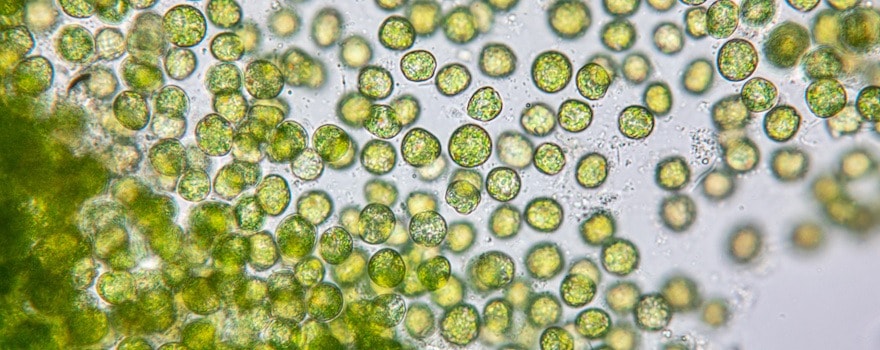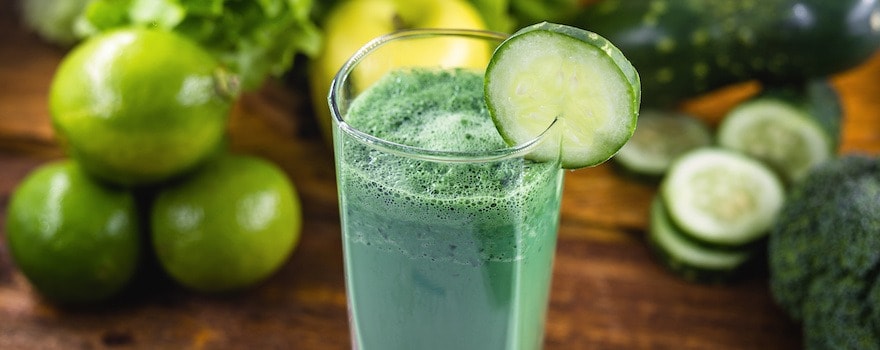VALIDATION SCIENTIFIQUE
Laure Fourchaud – 24.11.2021
Dr en physiologie de la nutrition
BENEFITS OF CHLORELLA
✓ Detoxifying
✓ Stimulates and regulates the immune system
✓ Powerful antioxidant protecting against oxidative stress
✓ Potentially anti-cancer
✓ Fights fatigue and improves depressive symptoms
What is chlorella?
Behind the name chlorella (Chlorella vulgaris) lies a truly remarkable microalga. Also called chlorelle, it takes its name from the Greek “chloros” (meaning “green”) and the Latin suffix “ella” (meaning “small”).
Originally from Southeast Asia, it is one of the oldest living organisms. Because of its great hardiness and its incredible ability to reproduce and regenerate, chlorella has been able to survive through the centuries to reach us. It belongs to the family Chlorellaceae, which includes several species of chlorella. Today, three main species are distinguished: Chlorella lobophora, Chlorella sorokiniana and Chlorella vulgaris, the most widely cultivated.
It takes the form of a microscopic alga that contains only a single nucleus and whose size is similar to that of a red blood cell (about 5 µm). It thrives in both fresh and salt water. In its natural environment, chlorella lives in symbiosis with certain freshwater species such as the paramecium, a unicellular organism.

Chlorella is considered a chlorophyte alga (or green alga) because of its deep green color, which it owes to its chlorophyll content. Chlorophyll is a pigment that enables chlorella to absorb the energy of light through the process of photosynthesis. Without roots or leaves, it is the only way for chlorella to grow and thrive in water. Discover another superfood rich in chlorophyll that we also love, matcha tea!
From a nutritional standpoint, chlorella is an exceptional microalga. Essential fatty acids, amino acids, proteins, vitamins, antioxidants… are all beneficial components for the body.
It is primarily known for its detoxifying action and its ability to absorb heavy metals from the body. But, as you will see, that is not its only beneficial effect. Chlorella has various properties that support the body’s overall health.
Today, chlorella is mainly consumed as a dietary supplement or in powder form. It is still the subject of extensive research to better understand its effects on the body and to discover properties previously unknown. This microalga could even become the fuel of tomorrow!
Nutritional composition
- Protéines
- 18 acides aminés (dont les 8 essentiels)
- Acides gras essentiels : oméga 3, 6 et 9
- Vitamines : A, B6, B9, B12, C, E, K1
- Minéraux et oligo-éléments : potassium, calcium, magnésium, fer, manganèse, zinc, cuivre…
- Pigments antioxydants : chlorophylle, caroténoïdes, lutéine

The benefits of chlorella
💎 Detoxifying
If chlorella enjoys a great reputation today, it is above all thanks to its detoxifying action. This microalga is highly effective at eliminating all of the body’s wastes : heavy metals (mercury, lead, aluminum…), pesticides, dioxins and other harmful substances. In addition to eliminating them, chlorella limits their accumulation in the body.
How does it work? Its cell wall contains sporopollenin. Behind this somewhat barbaric name lies a very resistant substance found in many plants. Once consumed via chlorella, sporopollenin binds to toxins and eliminates them through urine and feces. The alga’s detoxifying action is amplified by chlorophyll, which purifies the blood and detoxifies the body.
This study published in the medical journal Drug and Chemical Toxicology investigated the detoxifying action of chlorella on rats poisoned with chlordécone. The results showed that chlorella interrupted the circulation of the insecticide in the body before eliminating it in the feces.
🛡 Stimulates and regulates the immune system
The components present in chlorella have positive effects on the immune system. Its core notably contains the famous CGF (Chlorella Growth Factor, the chlorella growth factor), a unique complex made up of amino acids, vitamins, proteins and nucleic acids.
This combination stimulates immunity, particularly in older adults, and promotes cellular regeneration. The vitamin B12 contained in chlorella also contributes to the normal functioning of the immune system.
This study by the British Industrial Biological Research Association, conducted on rats exposed to lead, showed that chlorella promoted the production of new healthy cells in the body.
😷 Powerful antioxidant protecting against oxidative stress
Chlorella also has powerful antioxidant properties that protect the body from diseases and infections. Its action is due to fatty acids, vitamin C and vitamin E, carotenoids and the chlorophyll it contains. Chlorella is, in fact, the plant richest in chlorophyll !
Chlorophyll is a naturally antioxidant pigment. It protects cells from free radicals and stimulates the production of immune cells (macrophages and leukocytes). The chlorophyll contained in chlorella contributes to the oxygenation and detoxification of the body while maintaining acid-base balance.
This study conducted by the Graduate School of East-West Medical Science in Korea on 52 smokers shows that chlorella limited free radical damage to DNA.
🔬 Potentially anti-cancer
Like spirulina, chlorella is believed to have anti-tumor properties. Carotenoids, yellow-orange pigments, exhibit anti-cancer activity.
Chlorella also stimulates the release of interferons, proteins naturally produced by immune system cells. Interferons protect the body against viral, bacterial, parasitic, and tumor attacks.
Because of its antioxidant action, chlorella would also reduce cell damage caused by radiotherapy and chemotherapy.
This study from Universiti Kebangsaan in Malaysia, conducted on rats with liver cancer, shows that chlorella inhibited the proliferation of diseased cells and induced apoptosis, that is, the self-destruction of cancer cells.
⚡️Fights fatigue and improves depressive symptoms
Rich in vitamins and minerals, chlorella supports the body daily, combats fatigue (including chronic fatigue) and exhaustion. It is also very useful for relieving depressive symptoms.
Indeed, chlorella contains tryptophan, an amino acid precursor to serotonin or « happiness hormone ». It also acts on the release of melatonin to relieve sleep disorders.
This study conducted by various Iranian and Australian universities, on patients with major depressive disorder, demonstrated the effectiveness of chlorella in reducing anxiety and the physical and cognitive symptoms of depression.
🍭 Regulates blood lipid and sugar levels
Chlorella shows promising effects in reducing levels of bad cholesterol and blood sugar. This action appears to come from the phytosterols and the fibers contained in chlorella.
As shown by this study by various Iranian universities involving 70 patients, chlorella improves insulin sensitivity and increases the production of serum insulin responsible for maintaining normal blood glucose levels.
🏃♂️ May help with weight loss
Chlorella helps with weight loss thanks to its appetite-suppressing effect. It contains dietary fiber but especially phenylalanine, an essential amino acid that acts as an appetite inhibitor. A few minutes after consuming chlorella, the feeling of satiety sets in and snack cravings disappear.
Chlorella is a great ally for people on a diet because, in addition to helping with weight loss, it helps prevent deficiencies thanks to its exceptional composition.
How to consume chlorella?
Chlorella tablets

Tablets or capsules are made from dried chlorella powder . This form is readily available commercially. It offers several advantages: it is convenient, easy to take, and masks chlorella’s seaweed taste (if that displeases you!). However, chlorella in tablet form has a less favorable nutritional profile.
We mainly look into the processing method (which must preserve the active ingredients) and the content of pure chlorella.
Chlorella powder

Choosing chlorella powder is an interesting way to discover this microalga. You can cook with it (add it at the end of cooking). To avoid altering the active ingredients, chlorella powder should not be heated above 40°C.
You can also sprinkle it over a salad, mix it into a juice, or make a delicious smoothie with banana/apple/coconut/chlorella. Or simply dissolve it in a large glass of water or milk.
Fresh chlorella
Consuming fresh chlorella is the best way to enjoy its benefits. But this form is still very uncommon. Only a few manufacturers offer fresh chlorella, most often as a juice.
Opt for French chlorella
According to European standards, chlorella cannot be certified organic. However, it is recommended to choose chlorella grown in France.
Some chlorellas are produced in Asia and are much less traceable. Since the algae can absorb heavy metals and pollutants, it is important to verify its origin and the place of production. It will also have a lower energy impact if it comes from France.
Choose a pure chlorella, guaranteed free of traces of heavy metals and pesticides. Ideally, it should be cultivated in pure water and away from any sources of pollution. There are many small French producers; a simple internet search will let you find some near you!
Chlorella and spirulina
Chlorella and spirulina work very well together because their actions are complementary. Even better : they act synergistically and one amplifies the positive effects of the other. Taking them simultaneously is useful to benefit from the nutrients of each.
Chlorella and spirulina form an excellent balance. Spirulina, for example, contains more iron. Chlorella, however, has 4 times more chlorophyll than spirulina.
As shown by this study, it also contains active and bioavailable forms of vitamin B12, which can be relevant for people following a vegan or vegetarian diet. However, be careful to choose chlorella cultivated in natural light (in glass tubes). It is the only cultivation method that yields chlorella rich in vitamin B12. As a precautionary principle, we recommend medical vitamin B12 supplementation for vegans.
Chlorella and turmeric

The turmeric (Curcuma longa) is a plant whose properties are similar to those of chlorella. It is an antioxidant and also detoxifying, anti-stress, antidepressant and potentially anti-cancer. Combine turmeric and chlorella for a seasonal detox cure.
Chlorella dosage
⚖️It is recommended to consume between 3 and 4 g of chlorella powder per day.
🚴🏻♀️As part of intense athletic activity, athletes may exceptionally take up to 10 g of chlorella per day.
👶For children, the recommended dosage is 1 g of chlorella per 20 kg of body weight.
We recommend starting with small doses before gradually increasing the dosage. Due to its powerful detoxifying action, chlorella stimulates the release of waste in the body. Some symptoms may then appear. That is why it is important to adjust intake according to your body’s reactions.
⏳Chlorella is preferably consumed before meals. It can be taken daily, year-round, or as a 3-month course, twice a year.
💊In tablets : up to 8 per day for 500 mg tablets or capsules
🥄In powder : 3 to 4 g per day
Contraindications and side effects
Chlorella is a microalga well tolerated by the body. However, its use is not recommended for the following people :
- En raison de la forte teneur en fer de la chlorella, les personnes souffrant d’un excès de fer (hémochromatose) doivent éviter d’en consommer.
- Riche en phénylalanine, l’un des 8 acides aminés essentiels, la chlorella est déconseillée aux personnes atteintes de phénylcétonurie (accumulation de phénylalanine dans l’organisme).
- Les personnes sous traitement anticoagulant ne doivent pas prendre de chlorella car elle contient de la vitamine K1 qui intervient au niveau de la coagulation.
- Évitez de consommer du café en même temps que la prise de chlorella car elle démultiplie les effets de la caféine.
Taking chlorella generally causes few side effects. However, the following symptoms may occur (especially at the start of use) :
- Troubles gastro-intestinaux (ballonnements, diarrhées…).
- Maux de tête.
- Boutons.
If symptoms persist, it is advisable to stop taking chlorella and consult a doctor.
History, cultivation and market of chlorella
A brief history
Chlorella has a long history. The earliest traces of its existence date back 2.5 billion years, in Asia and more specifically in Japan.
It was through the work of botanist and microbiologist M.W. Beijerinck in 1890 that chlorella was described for the first time. He also added his name to chlorella’s scientific name: Chlorella vulgaris Beijerinck.
In the Land of the Rising Sun, chlorella had its moment of glory in the aftermath of World War II. It then became an important food source for the Japanese population. It was even considered a “food of national interest”.
It was finally in the 1950s that its reputation grew. Thanks to research, it was discovered that this microalga is a good source of essential fatty acids and proteins. But at that time, chlorella had one main drawback : it was very hard to digest.
Japan created, in 1957, the institute for research on chlorella to find the best way to exploit this alga. Neglected for several years, chlorella made its big comeback in 1970. Indeed, researchers finally succeeded in removing the alga’s cell wall. Composed of cellulose, it was this that made it indigestible.
Over time, research on chlorella multiplied and revealed its many properties.
Different cultivation methods
Chlorella can be cultivated in different ways :
- En bassins à ciel ouvert peu profonds : cette méthode est utilisée pour 95 % de la production mondiale. Elle a cependant l’inconvénient de ne pas protéger l’eau, et donc la chlorella, des polluants présents dans l’air.
- En fermenteurs (ou réacteurs hétérotrophes) : peu coûteuse, cette méthode ne permet pas d’obtenir une chlorella à haute valeur nutritive. En effet, l’algue est privée de son processus naturel de photosynthèse et ne se nourrit que de sucres présents dans l’eau.
- Sous tubes de verre : cette méthode est utilisée pour 1 % seulement de la production mondiale de chlorella. Et pour cause : elle est 10 fois plus coûteuse pour les producteurs qu’une culture en fermenteurs. Mais c’est pourtant la meilleure pour obtenir une chlorella de qualité ! L’algue se développe dans des tubes en verre placés au soleil et grâce à la lumière naturelle tout en étant protégée des polluants extérieurs.
Today, the island of Taiwan is the world’s leading producer of chlorella. Japan, China, India and Indonesia are also among the main producing countries.
Report prepared by Julia Perez and Charlotte Jean
Sources and scientific studies
Pore RS, 1984. Detoxification of chlordecone poisoned rats with chlorella and chlorella derived sporopollenin.
Mary L S Queiroz, Michelle Rocha-Parise, Cristiane O Torello, Julia de Souza Queiroz, Claudia Bincoletto, Marcelo Antonio Morgano, Miriam R Romano, Edgar J Paredes-Gamero, Christiano M V Barbosa, Andrana K. Calgarotto, 2011. Chlorella vulgaris restores bone marrow cellularity and cytokine production in lead-exposed mice.
Lee SH, Kang HJ, Lee HJ, Kang MH, Park YK, 2010. Six-week supplementation with Chlorella has favorable impact on antioxidant status in Korean male smokers.
Emey Suhana Mohd Azamai, Suhaniza Sulaiman, Shafina Hanim Mohd Habib, Mee Lee Looi, Srijit Das, Nor Aini Abdul Hamid, Wan Zurinah Wan Ngah, and Yasmin Anum Mohd Yusof, 2009. Chlorella vulgaris triggers apoptosis in hepatocarcinogenesis-induced rats.
Yunes Panahia, Roghayeh Badelib, Gholam-Reza Karamic, Zeinab Badelid, Amirhossein Sahebkaref, 2014. A randomized controlled trial of 6-week Chlorella vulgaris supplementation in patients with major depressive disorder.
Mehrangiz Ebrahimi-Mameghania, Zahra Sadeghib, Mahdieh Abbasalizad Farhangic, Elnaz Vaghef-Mehrabanyd, Soodabeh Aliashrafid, 2016. Glucose homeostasis, insulin resistance and inflammatory biomarkers in patients with non-alcoholic fatty liver disease: Beneficial effects of supplementation with microalgae Chlorella vulgaris: A double-blind, placebo-controlled, randomized clinical trial.



